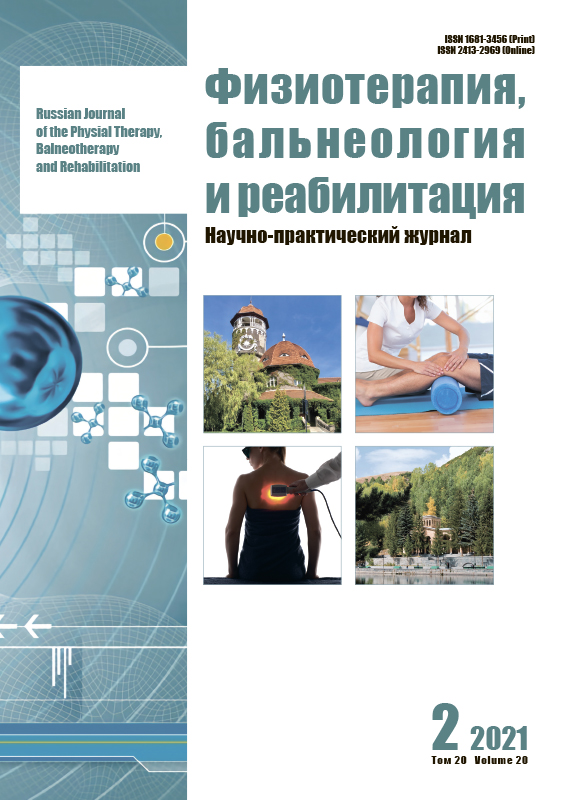Evaluation of changes in laser Doppler flowmetry indices in patients with a combined subtype of rosacea under the influence of a course of complex phototherapy
- Authors: Novikov K.A.1, Tamrazova O.B.2, Matushevskaya Y.I.3
-
Affiliations:
- Clinic of active longevity "Institute of beauty on the Arbat"
- Peoples' Friendship University of Russia
- Luberetskiy Dermatovenerologic Dispensary of the Ministry of Health of the Moscow region
- Issue: Vol 20, No 2 (2021)
- Pages: 125-136
- Section: Original studies
- Published: 15.03.2021
- URL: https://rjpbr.com/1681-3456/article/view/90001
- DOI: https://doi.org/10.17816/1681-3456-2021-20-2-4
- ID: 90001
Cite item
Abstract
BACKGROUND: The development of new methods for the treatment of rosacea, as well as a combination of various methods of physiotherapy, is of scientific and practical interest. In this work, the assessment of changes in microcirculation indices under complex phototherapy has been carried out.
AIMS: Тo assess changes in microcirculation indices in patients with a combination of rosacea subtypes according to laser Doppler flowmetry under a course of complex phototherapy.
MATERIAL AND METHODS: In 2017–2020 a randomized controlled study of 130 patients with a combination of rosacea subtypes. All patients were divided into 4 groups. In each separate group, laser therapy and 1% metronidazole cream were used (group I); phototherapy and 1% metronidazole cream (group II); complex photolaser therapy and 1% metronidazole cream (group III); in the comparison group (group IV), patients show only 1% metronidazole cream. The treatment, the duration of which was 3 months, included 6 sessions with an interval of 2 weeks. The effectiveness of therapy was assessed according to the data of laser Doppler flowmetry, reflecting changes in the hemodynamics of the microvasculature in the affected skin areas.
RESULTS: The developed complex method, including exposure to intense pulsed light (intense pulsed light, IPL) 520–1100 nm in combination with submillisecond neodymium laser radiation 1064 nm (submilisecond Nd: YAG laser 1064 nm) and daily application of 1% metronidazole cream showed the most pronounced improvement in the state of microcirculation according to laser Doppler flowmetry in comparison with the rest groups. Against the background of the course of complex phototherapy for all patients with the combined subtype of rosacea, statistically significant changes were in the volume of blood flow, modulation coefficients, coefficient of variation. On the contrary, no statistically significant changes were found in the ranges corresponding to active regulatory factors — endothelial, neurogenic, myogenic, and passive — respiratory and cardiac, as well as in the T index.
CONCLUSION: After the course of complex phototherapy in the group of patients with a combination of rosacea subtypes, there was a decrease in the severity of clinical manifestations of diseases, as well as an improvement in the main indicators of microcirculation according to laser Doppler flowmetry.
Full Text
About the authors
Kirill A. Novikov
Clinic of active longevity "Institute of beauty on the Arbat"
Author for correspondence.
Email: dr.novikov.ka@mail.ru
ORCID iD: 0000-0002-8127-8113
Russian Federation, Moscow
Olga B. Tamrazova
Peoples' Friendship University of Russia
Email: dr.novikov.ka@mail.ru
ORCID iD: 0000-0003-3261-6718
MD, Dr. Sci. (Med.), Professor
Russian Federation, MoscowYuliya I. Matushevskaya
Luberetskiy Dermatovenerologic Dispensary of the Ministry of Health of the Moscow region
Email: dr.novikov.ka@mail.ru
ORCID iD: 0000-0001-5995-6689
MD, Cand. Sci. (Med.)
Russian Federation, Moscow region, LubertsyReferences
- Kruglova LS, Bakulev AL, Sofinskaya GV. The use of ivermectin and brimonidine tartrate in various subtypes of rosacea: studies.- method. stipend. Moscow; 2017. 25 р. (In Russ).
- Steinford M, Schauber J, Leyden JJ. New insights into rosacea pathophysiology: a review of recent findings. J Am Acad Dermatol. 2013;69(6 Suppl 1):15–26. doi: 10.1016/j.jaad.2013.04.045
- Egorova OA, Agafonova EV, Kruglova LS. Comorbidity with rosacea. Hospital Medicine: Science and Practice. 2018;1(1):23–29. (In Russ).
- Kruglova LS, Egorova OA. The role of cosmetics in the treatment of rosacea. KI-KOSMETIK; 2018. Р 106–111. (In Russ).
- Kubanova AA, Kubanov AA, Samtsov AV. Federal clinical guidelines for the management of rosacea patients. Russian Society of Dermatovenerologists and Cosmetologists; 2015. (In Russ).
- Kogan BG, Golovchenko DY. Modern approaches in the complex treatment of patients with demodecosis and pink acne. Russian Society of Dermatovenerologists and Cosmetologists. 2011;1(40):38–43. (In Russ).
- Tan J, Berg M. Rosacea: current state of epidemiology. J Am Acad Dermatol. 20013;69(6 Suppl 1):27–35. doi: 10.1016/j.jaad.2013.04.043
Supplementary files



















